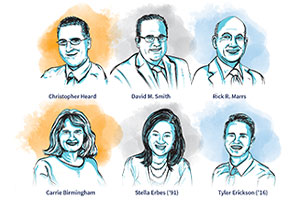Class of 2020
When the global coronavirus outbreak shifted the nation’s classrooms from traditional to digital, Pepperdine educators found themselves ahead of the curve
When Elena Doudenkova moved to California from Switzerland to pursue a career as a therapist, she was relying on stimulating classroom discussions at the Graduate School of Education and Psychology to help her develop intimate friendships in a foreign land. But in spring 2020, Doudenkova learned, along with more than 76 million other students across the United States, that the nation’s K-12 schools, colleges, and universities were shuttering indefinitely to limit the spread of COVID-19 across thousands of campuses.
During an ever-changing period of uncertainty and fear for the safety of their communities, many schools transitioned their lesson plans to an online format, leaving instructors little time to explore new technologies, master distance learning methods, and adjust their curriculums accordingly.
As Pepperdine began the process of moving to a remote instruction format the week of March 16, Christopher Heard, professor of religion and director of the Center for Teaching Excellence at Seaver College, discovered that Pepperdine was better positioned than most institutions to navigate the new reality of the online classroom. Pepperdine faculty had experienced a similar situation for two weeks in November 2018 when the Malibu campus was closed during the Woolsey Fire. Frequently partnering with recognized experts in online learning best practices, Heard played a critical role in quickly reorienting the faculty as the University once again adapted to the limitations brought on by an unexpected crisis.
Heard emphasizes that developing a strategy to deliver a cohesive educational experience online is significantly different from simply shifting to remote instruction during an emergency situation, especially if the remote lessons include a video component. In a Zoom session, for example, Heard says that the flood of visual noise, like that created from each individual participant’s actual or virtual background scene, can be a great distraction that could lead to a phenomenon known as Zoom fatigue. He says in-person meetings and live interactions often leave participants feeling more energized.
Beyond Pepperdine, Heard often collaborates with numerous Center for Teaching Excellence facilities across the United States. His Rapid Onboarding to Online Teaching course, a 10-day program featuring videos, readings, and offline activities, which launched in April 2020, was accessed by 150 external educators and completed by more than one-third of Seaver College faculty who taught classes online in May or June.
According to David M. Smith, professor of economics at the Graziadio Business School and associate provost for online learning at the University, the most productive online classrooms offer a strong sense of community through meaningful engagement during synchronous instruction—learning that happens in real time—an element he believes is a cornerstone of the Pepperdine framework. But while the technology supporting the online classroom continues to evolve, one key element of communication—eye contact—is relatively unattainable, further hindering the expression and reception of critical nonverbal communication.
Smith predicts that within the next 10 years, 50 percent of all graduate programs will be fully available online, compared with the current 30 percent, and that the future of undergraduate studies will offer more mix-and-match options between traditional and online settings.
“Even though different, the online classroom can be rigorous, engaging, enriching, and transformational. Some things are best accomplished in person, but some things can be better accomplished online,” says Smith. “The online classroom is always ‘open,’ so students have the flexibility to work on their education when they have the time. They also tend to participate in the classroom all through the week with a cadence that can be more regular than the on-ground classroom.”
In fact, Rick R. Marrs, provost and chief academic officer at Pepperdine, has noticed that digital materials are already replacing physical materials at college campuses across the nation—a trend he suspects will increase. He also shares that libraries are increasingly allocating funds toward digital databases rather than hard copies. In light of this finding, Pepperdine faculty continue to familiarize themselves with and use online resources to keep their lessons on track.
“Teaching the same course online is really like teaching a new course. Having to suddenly develop and deliver a few new courses within a couple of days is a heavy undertaking, especially with the additional challenge of potential distractions within a full house,” says Marrs of the faculty’s new work-from-home routine. “Our professors are incredibly conscientious of the challenges of the transition and have worked tirelessly to make this as seamless as possible for all our students.”
 A Lot to Learn
A Lot to Learn
As countless institutions ranging from preschools to colleges and universities scrambled to master the latest technologies to continue delivering their lesson plans online, many teachers were apprehensive about transitioning to online classes. To help ease the transition, Carrie Birmingham, associate professor of education at Seaver College, and her students created a YouTube channel featuring original read-aloud videos and interactive lessons for young children.
Based on her expertise, Birmingham says, “Human connection is the foundation of teaching and learning. Every student needs to belong, be included, be accepted, and have a significant voice in the learning process.”
According to Stella Erbes (’91), divisional dean of the Humanities and Teacher Education Division and associate professor of teacher education at Seaver College, one significant element typically missing from online courses is varied instruction. Erbes advises instructors to use a combination of media, chats, polls, and games to teach students of all levels online and urges teachers to give more thought to reformatting lessons as more classrooms transition to the digital space.
“Don’t talk for two hours straight in a two-hour class,” she shares, expressing that more discussion does not result in higher retention. “It’s easy for us to memorize songs, so why is it so hard to retain academic knowledge? Let’s teach for long-term memory retention and retrieval rather than for regurgitation for a good grade on an exam.”
Fifth-grade teacher Tyler Erickson (’16), a former student in Erbes’ instructional design course, has been doing just that. Erickson maintains the human connection in his online classroom through a variety of teaching scenarios, like opening the day with a morning prayer, offering a time for students to share all the ways the quarantine has had a positive impact on their lives, asking students to discuss their weekend plans, and providing different Zoom chat rooms for breakout sessions and discussions.
When Erickson first learned that Oaks Christian School in Los Angeles County would shut down for three weeks during the spring semester, he didn’t break a sweat. Thanks to his Pepperdine background, Erickson was one of four teachers selected to be on the private school’s “tech squad”—half of which were Waves—to help the rest of the faculty prepare for what would become a months-long education process.
Kolby Wagner (’20) brought the experience with online learning technologies that she had in Birmingham’s class to her job student teaching at Sequoia Middle School in Thousand Oaks, California. Wagner’s know-how allowed her mentor teacher—whose lack of online software training made her hesitant about the transition—to continue offering her math classes via Zoom. Thanks to Wagner’s preparation, her math students are both keeping up with the required curriculum and enjoying socializing because “they all miss each other.”
As Birmingham puts it, “Good teaching begins with students, not with standards—with high hopes, not rigid expectations. What students learn has to be meaningful to them, and this has been a fantastic opportunity to redefine what we consider ‘learning.’”
 Terms and Conditions
Terms and Conditions
As the spring 2020 semester came to an end and summer sessions commenced in May, Heard reveals that many faculty reported an increased sense of community in their online classes. While professors who transitioned to remote instruction in the spring had the advantage of having spent two months getting to know their students in a physical classroom, faculty who started online courses in May reported similar successes in building classroom community in the digital space.
Smith asserts that, although it was a massive undertaking to move hundreds of classes to a remote instruction framework, University data shows that students were generally satisfied with the efforts to sustain learning through the pandemic, even on par with what is typically seen in the traditional classroom. Pepperdine has also witnessed a significant boost in faculty’s ability to use technology to facilitate learning, and some of these skills are transferable to the in-person classroom learning environment.
Moving forward, Heard notes that some of the same technologies that were used for remote instruction may remain in place as the University addresses logistical challenges with on-campus classes when they eventually resume. For example, some classes may move into larger-than-usual spaces to accommodate social distancing protocols, along with wearing face coverings during lectures, discussions, and other types of class sessions. Consequently, new distance practices in the classroom may present challenges related to hearing and understanding, a potential drawback that video conferencing software may help alleviate.
“The combination of faculty intentionality and student responsiveness during this time has been incredibly fruitful,” says Heard. “As these efforts continue, they will help the University preserve its distinctive ethos—even in a markedly changed environment.”
